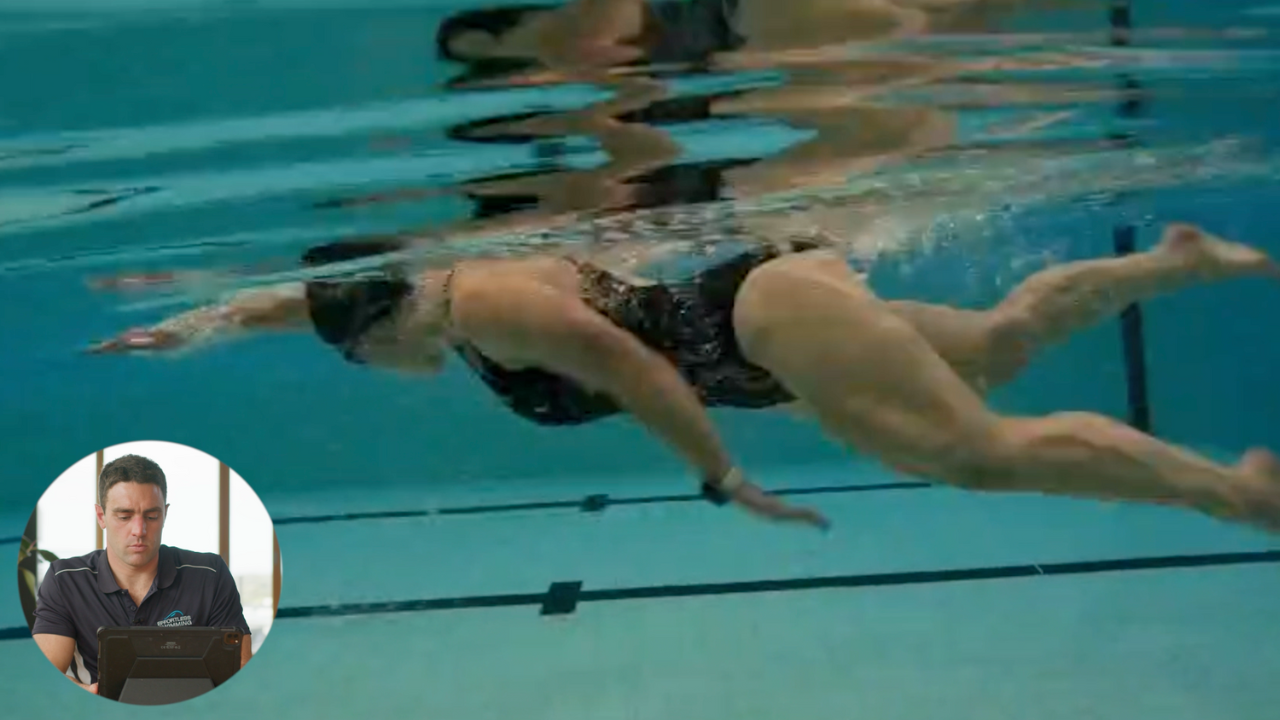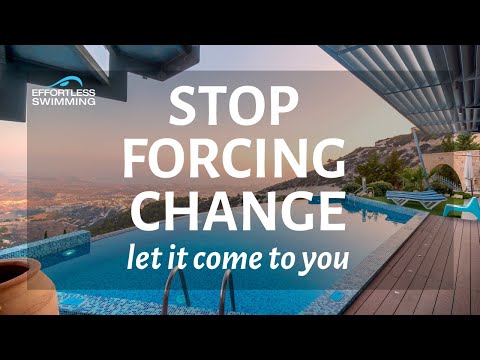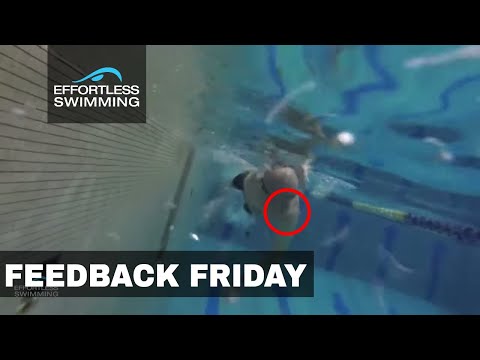The swimmer we’re looking at today competes in triathlon and currently races at 1:38/100m. We look at the following things in his stroke:
– Head position (too deep at times)
-Shoulders over-rotating causing his arm to go deep and elbow to drop
-Left hand entering close to the head, needs to go further forwards
Transcription:
Get that elbow out to the side and somewhere in that sort of range. So that’d be 106 degrees. That’d be the power diamond that we’re looking for. And again, that’s just going to help him really use those lats and it’d be basically a lot more power applied for a lot less effort there.
Hey, Brenton here. Welcome to Feedback Friday. In these episodes, we look at someone swimming and we analyze their stroke and we give them a couple of ways that they could increase their speed, reduce their effort over the course of the next few months. And in this video we’ve got a triathlete, Stuart, he’s swimming around the 1:38 pace per 100 for his triathlon events. And you’ll see in this video he’s got a good rhythm and there’s a lot he’s doing really well in his stroke. So what I’ll focus on here is mostly what he’s doing with the arms. So a few different parts of the stroke, but the overall really good rhythm and timing in the stroke.
So the first thing I’d look to do here is inch a little bit further forward with the left arm. When you look at it from the side here, you’ll see that this left-hand enter just a little bit early on some of these strokes. So you can see it coming in and it is relatively close to the head and that angle’s just a little bit steep and it’s probably more evident when we look at the open water footage here.
You’ll see how close it comes into the head. So what I sort of like to see with most people when they enter is entering out in front. We want that triangle shape on the entry, so the elbow should be up, fingers should be first, but just going a little bit further out because if you enter really close to your head, it’s a lot more time spent reaching forwards in front of you. And that can increase the drag, it can slow you down a little bit, and that angle can be quite steep as it goes in, which again, just increases the drag there. So most of the time you want to enter with that triangle sort of shape but not too steep. The right arm comes over and inches pretty well there. It’s almost at full extension but he’s still leaving some room to slide the hand forwards in the water and that’s what we want.
So first thing would be, get that left-hand to enter further forwards and for him to change it, he will more than likely have to feel like he’s entering a long way out, like a really long way out there. And you can see here under the water it comes in quite steep in terms of this angle and when he finishes reaching forwards there, he’s just maybe a little bit deep on some of these strokes, like there when he finishes reaching, I normally like to see the fingertips about armpit depth and so it’s a very slight downwards angle there. So he’s only five to 10 centimeters too deep there. But again, that will increase the drag that gets created on top of his arm there. So we would just want him to finish that a little bit higher. Now, the other reason for that is, if he starts up a little bit higher here, it’s going to give him a little bit more room to set up the catch, which will just make it a little bit easier for him.
And if we look at the catch and the pull, this is really going to be the main focus point because the timing of his stroke is good. His recovery, in general, is really good. His alignment is as well. So where he’s going to find the biggest increase in speed is just continuing to work on the catch in the pull. So if we look from the front, which we’ve got here, one of the things that we like to look at is what are the angle of the arms is they’re about to pass under the shoulder. So he enters, goes through the catch, starting the pull here. Now in this part of the stroke, we like to look at what’s the angle of the arm and with the [inaudible 00:03:27] measure find, this is typically 100 to 120 degrees. If we look at the bend in the elbow.
So he’s 154 degrees at the moment. All that means is his hand is just a little bit deep. The arms, a little bit too straight. And a little bit too straight to really help him use the stronger muscles through the shoulder and through his back there. So if he’s able to get the hand to go a little bit shallower and bring the hand on the inside of the elbow. So we genuinely don’t want the hand to be wider than the elbow because it just makes it harder to get into your lats there. So fingertips, if we bring it up to say here, get that elbow out to the side, keep that hand on the inside. This is what we call the power diamond position. So if the arm can make this half-diamond shape as he’s passing under the shoulder, that will allow him to use those stronger muscles. And that’s where you see all those top summers in that sort of position.
So that sort of angle would be 116 degrees. That’d be within that 100 to 120 that we generally want to aim for. And that’s not only going to help him use those stronger muscles, but you’ll also find that his hand and forearm will be better positioned when we look side-on, better positioned to just have more surface area facing back behind him, which will help him move forward there. So that’s the left arm is just going a little bit deep and a little bit wide there. The other thing that he may need to change here is just to reduce his rotation. So the rotations a little bit far, if I measured that right, about 52 degrees, that’s really on the upper end of rotation. Typically, we’ll say most top swimmers 40 to 45, so I encourage him to just reduce that rotation a little bit, which will probably help him not go as deep on that arm because those two things can often be connected.
If you know you’re going down really deep and straight with the arm, check your rotation. If it’s more than about 50 degrees, then you’d probably want to reduce it. On this right-hand side, the rotation looks good there. But again, just going that little bit deep and a little bit straight. So arm angles around 150. Again, fingertips get a little bit shallower, get that elbow out to the side and somewhere in that sort of range. So that’d be 106 degrees, that’d be the power diamond that we’re looking for. And again, that’s just going to help him really use those lats and it’d be basically a lot more power applied for a lot less effort there. And that’s really the number one thing I’d focus on here because we want to focus on what’s going to make the biggest difference with your speed and for this swimmer, because he’s got great body position, head position and posture’s good. That’s going to be the key.
Because when we look from the side here, if we have a look at all right, that’s the end of his catch. How’s his catch looking? It’s in a slightly dropped elbow position. All right, so you can see how the elbow slightly dropped there. What we want to work towards is somewhere in that high elbow range and it doesn’t need to be much as you know, just somewhere in that high elbow range can be really, really effective and he’s not far from it. Probably just needs to reduce that shoulder rotation a little bit. Needs to not go quite as deep and he probably just needs to follow some, a good drill progression like the YMCA drill progression that we’ve got inside the membership there. And you’ve probably seen the first of those drills, which is the YMCA drill, which basically just breaks down the catch and the pull into the most important aspects of it.
And it gives you the time and the space to be able to just make a couple changes in your stroke and make sure that you get them 100% and you know how it feels when you’re in that right position. So he’s not far off it at all. So that’s really where I’d spend my time if I was this athlete.
Now the other thing that can be helpful to look at, we can seem swimming in the open water here and we’ve only got the above water shot. But what I’d look to do here is, as we said, get that left hand, further forwards. I’d also probably get him to still just reduce that rotation a little bit on this side. Let’s check that there. He’s still just rotating a bit far even in the wetsuit there, but overall swimming well. And if we look at his siding, all right, so he’s using sight and breathe method, looking up, turning to the side on the next stroke. That’s a really good use of it.
Now he doesn’t even need to come up that high when he, when he sights, although that one was a lot lower. So you can see there, eyes just above the water on the next stroke turns his head to breathe. That’s a really good use of the sight and breathe method. So he’s going really well and he’s probably, I’d say he’s probably, two to four months away from being able to get around that 1:30 pace if he was to focus on that left arm entering further out and working on the catch and the pull.
It’s going to feel a bit strange for him. It’s probably like he might even fatigue a bit quicker because one of the things I like to sort of preface these changes with is, you’ll be using different muscles. And so you might find that after 400 or 500 meters of that different stroke, you’re actually a lot more tired than you would be than if you’d done 1000 meters of your current technique. But it’s just because you’re using different muscles. But if you can put up with that for three or four weeks, you’ll often find that those muscles get stronger, they get used to those movements and you won’t notice a difference within three to four weeks. But it does take that time. So often it just means you’ve got to be patient it and sometimes you will regress. You will go that a little bit slower early on in order to get faster down the track.
But if you can put up with that, those couple of weeks of maybe frustration and annoyance and not going faster, that’s when you often get that improvement, eight to 10 weeks down the track. And we see that all the time with some is that at clinics. I often get emails from people who have been to a clinic two months ago, three months ago, and they say, they actually say, “I got slower. I was, I thought I was going backward but then all of a sudden it clicked.” And this is sort of six, seven, eight weeks down the track and they’ve made those improvements and their times have jumped five, 10 seconds faster per 100 when it’s all come together. They’ve got that muscle memory in place and the muscles have gotten that little bit stronger because they’re using those different muscles. So if you can put up with that, then you’ll often find yourself going faster.
But the swimmers that can’t put up with it and they just go back to what feels comfortable, they’re the ones that often don’t quite make those changes. So if it doesn’t feel different than it’s probably not different. And that’s a good kind of rule to go by when you’re looking to change a stroke. So if you did enjoy this video, please like and subscribe and share it with someone who you know is looking to improve their swimming. It helps us get the word out. And I do a lot of these videos every week and all I ask is if you can share this with other people who you know are swimming then that really helps us spread the word.
And there are a few ways that you can work with myself and us is we run clinics around Australia. So we do those in most of the capital cities. We also run camps, which we’ll have a lot of camps coming up in 2020 in Australia, Thailand, and Hawaii. And that’s where you can work with myself and the other coaches for five to seven days. And that’s where we do underwater filming and one-on-one coaching on a daily basis. And you’ll work really closely with myself and the other coaches there.
And we also do online coaching where you can send your videos just like this and I’ll do an analysis for you. And we work together on an ongoing basis. And we’ve seen some massive changes in people’s technique over the course of 12 months and 18 months, sometimes up to 30 seconds faster per 100. And really commonly five, 10, 15 seconds faster per 100 depending on where the swimmer’s at. So there’s no reason why you can’t get faster in your swimming because it is a learned skill. It just means you need to focus on the right things. So thanks again for watching and I’ll see you next week with another video.










